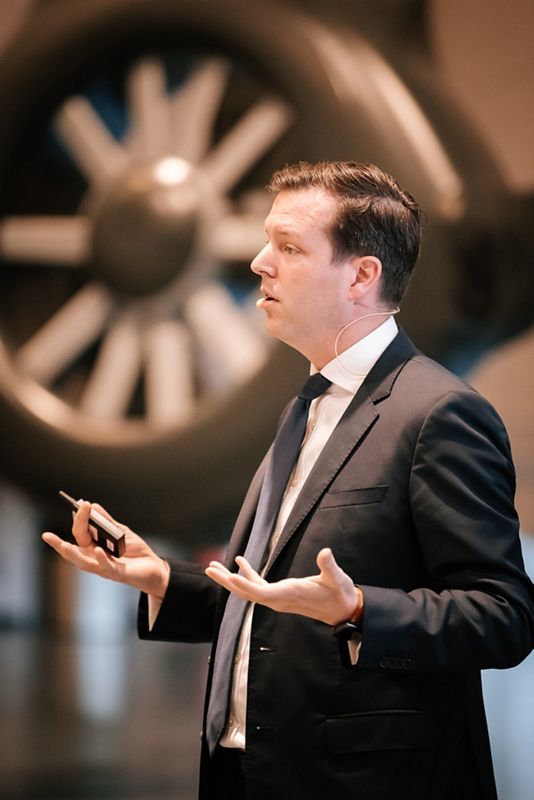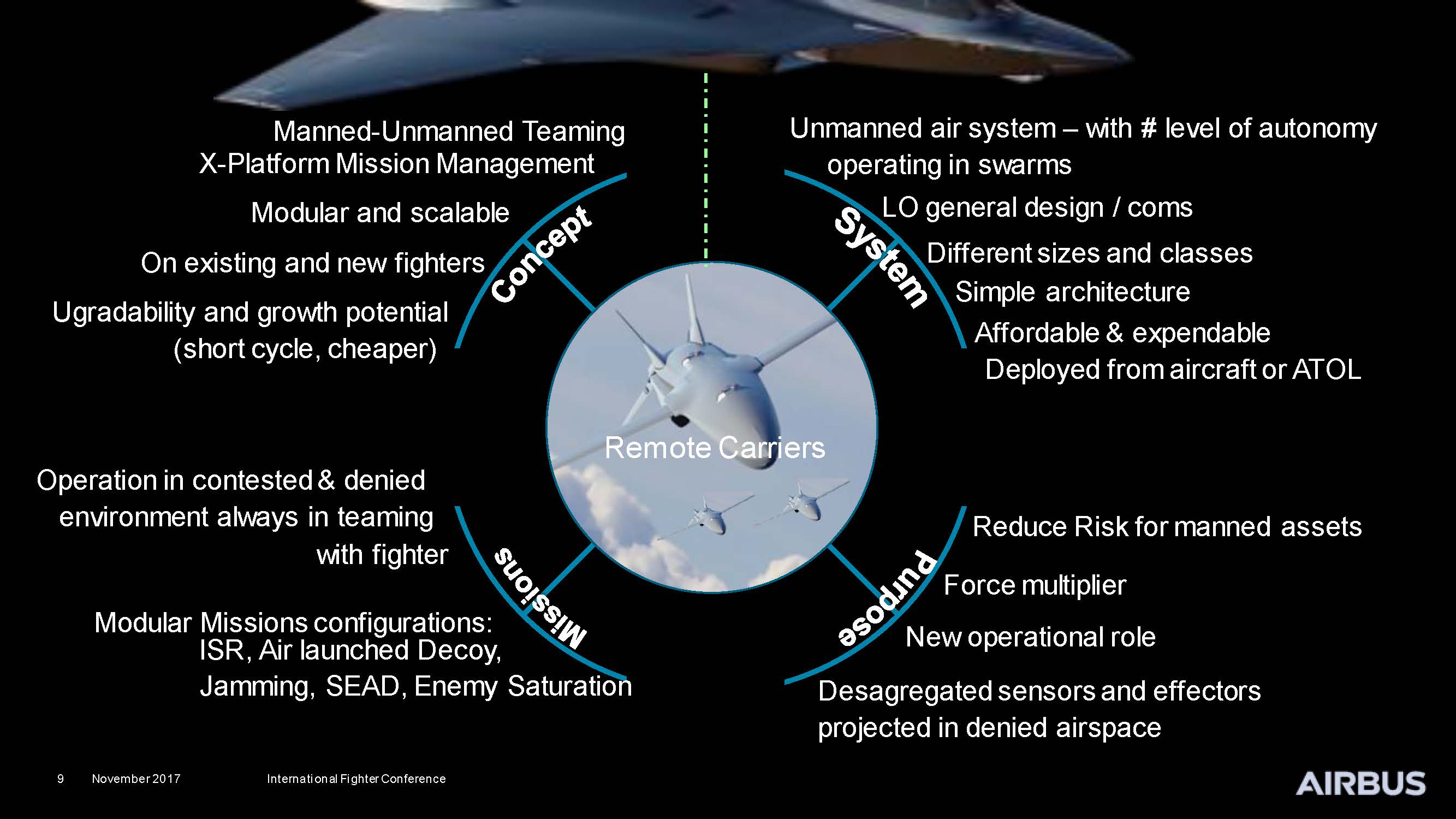By Robbin Laird
At last year’s International Fighter Conference, the team working on the Franco-German Future Combat System program provided an overview on the launch of the effort. At this year’s conference, the team provided an update on progress over the first year, and underscored key timelines into what was called an incremental approach to building a new fighter by 2040.
And now Spain has joined the program as well.
I provided an update on this year’s overview in a separate piece.
But in this piece, I want to look at one key element of the future combat system, one which will need to be introduced into the evolving combat force, and not wait until 2040.
A key element of building the connected force is clearly the question of the nature and capabilities of remote carriers to work with manned systems in the air.
Remote carriers will become part of the evolving combat force in the near to mid-term.
This has become a key dynamic associated with the changes in C2 revolving around enhanced artificial intelligence built into the force, but a clear need to both evolve data linked weapons – which after all are the first round of manned-unmanned teaming already in the sky.
Remote carriers are coming with the various loyal wingman approaches as well within which current fighters work with evolving remote capabilities to deliver a combat effect from the teaming capability.
It is clear that remote carriers will become key force multipliers and shape new concepts of operations going forward as they are added to air combat fleets.

During the conference, I had a chance to continue my conversation began last year on this topic with Bruno Fichefeux, Head of FCAS for Airbus Defence and Space.
From my perspective, Airbus has already delivered two key 21st century air platforms – the MRTT tanker and the A400M airlifter – which should provide useful launch points for the redo of air combat along the lines envisaged by the FCAS.
And doing so makes business interest for Airbus, and not just for those air forces flying Rafale or Eurofighter.
To highlight the opportunities, in an interview I did last year at Amberley Airbase in Australia, the Wing Commander charged with operating the KC-30A or the A330MRTT, a la Australian, focused on how he saw the future of that tanker.
According to Group Captain Steve Pesce, Officer Commanding 86 Wing, comprising the RAAF’s C-17, KC-30A, B300, CL604 and B737 fleets, in a conflict against a “near-peer” adversary the RAAF and allied forces may not have the luxury of secure tanking in uncontested airspace.
Air forces will gain transient advantage rather than total control of the air and will support surface assets that will be more dispersed across a larger Area of Operation (AO). Demand for AAR (and air mobility in general) will increase as the survivability of a large tanker is reduced.
Distributed operations in contested airspace will become a norm, and that means in his view the end of the classic larger tanker operations. The manned tanker will operate further away in the battlespace and become the mother ship for tanking remotes operating as refueling nodes to expendable assets deployed forward,
“My view of the future battlespace is that sensors and shooters will be more proliferated, integrated and reach further and with greater precision.
“There will be a natural move towards dispersion to improve survivability and delivery of fuel will be critical.
“The future of a large tanker will be to support more distributed and dispersed operations and we will be looking at small tactical refuelers providing fuel to tactical air combat assets – these tactical assets will likely be cheaper, unmanned and more expendable.
“That is where A3R comes in.
“I see an advantage in the automatic boom because it reduces the workload on the operator who in the future may be managing or controlling formations of UAV during AAR.
“As we learn to use this technology, it will be part of shaping the skill sets to transition to the next phase, of a large tanker replenishing smaller, automated tactical refuelers….”
As Airbus Defence and Space is a global business, it would make sense as the FCAS program generates manned-unmanned teaming capabilities that such capabilities would be made available to its global customers in the tanker program, for which there are many, and for the A400M program which there are fewer but certainly more than the core participants into the FCAS program itself
Bruno Fichefeux confirmed that this proposition is being studied within Airbus Defence and Space.
He argued that there were two ways in which Airbus Defence and Space was addressing the opportunities within and eternal to the FCAS program.
First, for each of its key platforms such as tanker and A400M, they were shaping road maps for the development of the platforms which highlighted ways to enhance their capabilities within an integrated and connected battlespace.
Second, they are shaping technology streams which are designed to deal with the different challenges within manned-unmanned teaming.
Those technology streams can be drawn upon to shape developmental opportunities for the existing or new platforms envisaged in FCAS.
With regard to the first, the focus of what has been called the smart tanker program is precisely designed to shape ways ahead to use the space within the tanker for enhanced contributions to the integrated battlespace.
It must be remembered that the fuel carried by the A330MRTT is carried in the wings, which leaves the large cabin free to do other missions, which now are largely devoted to movement of warfighters and support staff or to carrying cargo.

According to Fichefeux: “Smart MRTT is focused on how to make use of all the internal space and to leverage it for the other platforms in the combat system and to increase their situational awareness and to handle data transfers.”
Another example is the A400M and its potential role as a remote carrier.
According to Fichefeux: “We have initiated a series of design studies looking at how we can operate the A400M as a launcher and recovery platform for remotes, and operating as a mother ship so to speak.
“In this sense, the A400M becomes the wingman for the fighter fleet, but by functioning as a mother ship to launch and recover remotes which can go deeper into the battlespace to provide broad support for the tip of the spear of the air combat force.”
In addition to working to study capabilities of its two core new air combat assets, namely the tanker and the A400M, Airbus Defence and Space has launched a series of “technology streams” examining how to develop a manned-unmanned teaming capability.’’
According to Fichefeux: “We have launched generic technology streams, where we are looking to mature technologies around swarming, around level of autonomy, around the teaming intelligence, around how do we display this teaming for future fighter cockpit. How does the fighter pilot and the drones work together?
“We are running these technology streams concurrently with developmental streams and are targeting the introduction of remote carriers on the Eurofighter platforms to extend the range of its capabilities and to fill the combat gaps.”
And to my earlier point that in many ways data linked weapons are the precursor of the manned-unmanned teaming envisaged with regard to UAVS, fighters, lifters and tankers working together, he underscored the working relationship between Airbus and MBDA.
Fichefeux underscored that they were working on the spectrum of unmanned platforms with various size and operational characteristics to think through a technology and development tree to introduce such capabilities into the combat force.
For example, with regard to the smaller remotes, they have teamed with MBDA to leverage MBDA’s experience in operating data link weapons.
“In the design of remote vehicles of a smaller size category, Airbus and MBDA are working together which allows us to leverage their experience and gives them access to our thinking and developments with regard to remote carriers which will carry evolving sets of weapons in the future”.
And, of course, the overall technology developments are clearly affecting thinking about new platforms.
In no case is this clearer than the European MALE RPAS program.
When Airbus Defence and Space presented their focus on European MALE RPAS few years ago at the last Airbus Defence and Media day, clearly the European MALE RPAS one saw glimmers of such thoughts.
But with the FCAS launch these glimmers are becoming solidified in a programmatic sense.
In short, Bruno Fichefeux laid out the incremental approach of Airbus Defence and Space in the crucial area of manned-unmanned teaming and the importance of integrating new remote platforms within the concepts of operations of air combat fleets.
While the strategic objective of FCAS is clearly to deliver a new combat fighter, the focus is very much on delivering key building blocks along the way.
And new remote platforms are such a building block.
Airbus Defence and Space are looking to add new remote platforms which can work with existing air combat platforms, including fighters as well as other air combat assets, such as air lifters and airborne tankers.
In short, they are looking to deliver a System-of-Systems, connecting platforms, operating across domains, and being fully interoperable with allied forces instead of “only” targeting a new combat fighter qua a new platform.
Also, see the following:
An Update on the Future Combat Air System: International Fighter Conference 2019


